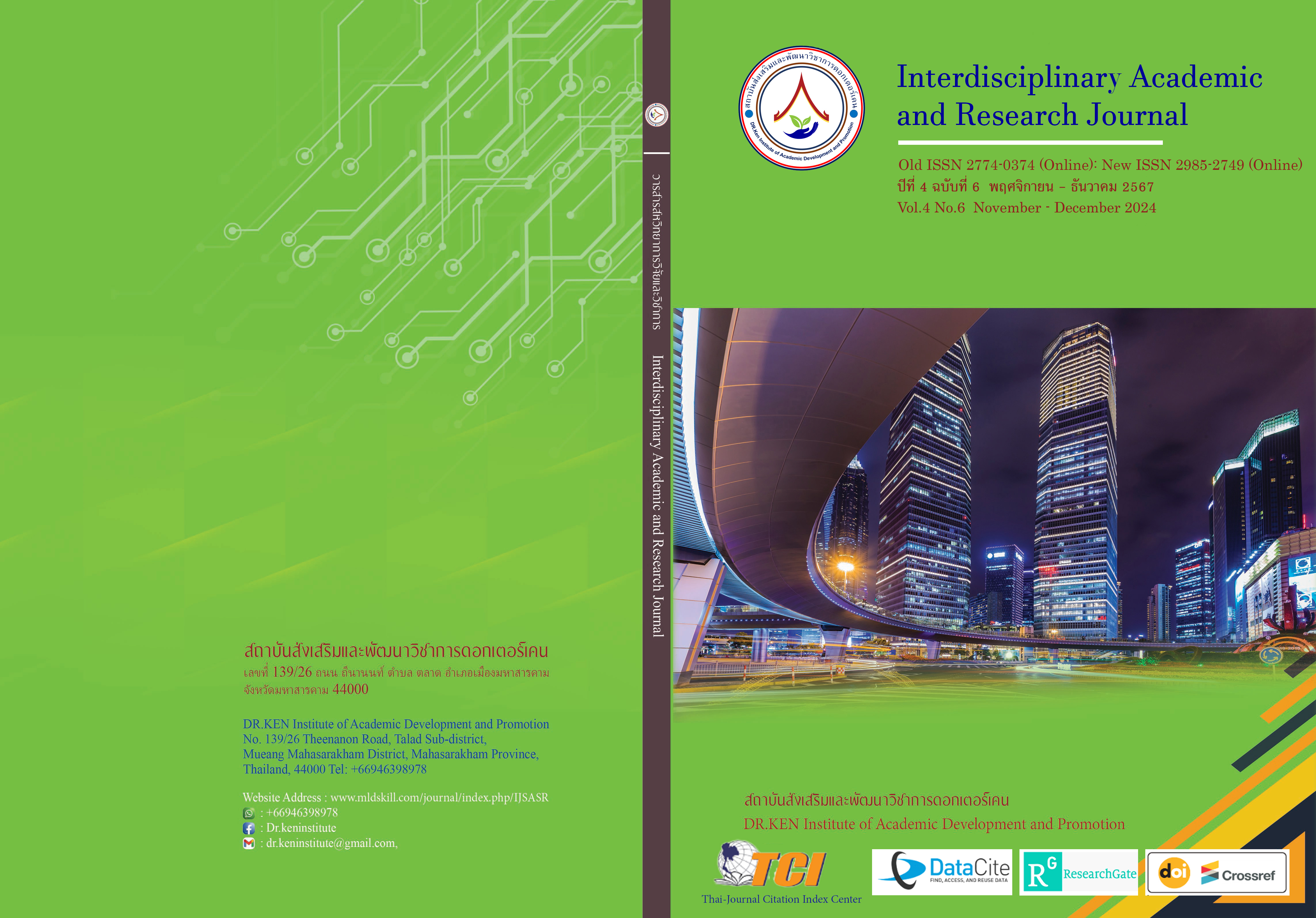The Development of Mathematics Instructional Model to Promote Analytical Thinking Abilities of Sixth Grade Students
DOI:
https://doi.org/10.60027/iarj.2024.278699Keywords:
Instructional Mode, Analytical Thinking, Mathematical Analytical ThinkingAbstract
Background and Aims: Developing a mathematics teaching model is especially important for students as they develop their ability to think critically and solve problems. Necessary in daily life The objectives of the research are 1) to study the conditions and problems of organizing mathematics teaching and learning. To promote the mathematical analytical thinking abilities of Grade 6 students. 2) To develop a mathematics teaching model. 3) To experiment with the teaching model.
Methodology: This research is a mixed method. The research is divided into 3 phases as follows: Phase 1. Data collection tools used questionnaires. The sample group consisted of 282 Grade 6 students and teachers who taught mathematics. Mathematics learning group, 55 people, totaling 337 people, and interviews with 9 teachers, data analyzed using PNImodified and qualitative data, Phase 2, model development using seminar methods based on 5 experts, Phase 2 3 Implementation and evaluation of the use of teaching models Statistics used in data analysis included mean values, percentages, standard deviations, and statistics (t-test).
Results: The results of the research found that: 1) problem conditions in organizing mathematics teaching and learning activities To promote mathematical analytical thinking abilities of students in Grade 6 were overall at a moderate level. And there is a condition that should be there with the need to organize activities. Overall, it is at a high level. 2) Mathematics teaching format To promote mathematical analytical thinking abilities For Grade 6 students, there are a total of 6 elements as follows: 6.1 Principles 6.2 Basic concepts, principles, and theories 6.3 Aims 6.4 Teaching and learning process 6.5 Model use 6.6 Evaluation (PORCA Model) 3) Students who learn with porca pattern Have an average score in mathematical analytical thinking ability After studying, after studying above, learning in a normal way. and overall satisfaction was at a high level.
Conclusion: According to the research, there is a high need for well-planned activities and a moderate level of success in fostering analytical thinking in Grade 6 mathematics instruction. The principles, concepts, goals, procedure, application of the model, and assessment of the suggested PORCA model greatly improve students' analytical thinking and sense of fulfillment in learning.
References
กระทรวงศึกษาธิการ. (2561). แผนแม่บทเทคโนโลยีสารสนเทศและการสื่อสารเพื่อการศึกษาของกระทรวงศึกษาธิการ พ.ศ. 2560-2564. กรุงเทพฯ : แผนกเทคโนโลยีสารสนเทศของกระทรวงศึกษาธิการ.
กัญจนา จันทะไพร. (2558). การพัฒนารูปแบบการสอนคณิตศาสตร์ตามแนวทฤษฎีการสร้างความรู้เพื่อส่งเสริมทักษะการคิดวิเคราะห์ของนักเรียนชั้นประถมศึกษาปีที่ 5 เรื่อง การบวก การลบ การคูณทศนิยม. วารสารวิจัย มข. (ฉบับบัณฑิตศึกษา) สาขามนุษยศาสตร์และสังคมศาสตร์. 3(3), 1-11.
ชมนาด เชื่อสุวรรณทวี. (2556). การพัฒนารูปแบบการเรียนการสอนคณิตศาสตร์ เพื่อส่งเสริมความสามารถในการคิดขั้นสูงและจิตตนิสัยของนักเรียนระดับมัธยมศึกษา. Silpakorn Educational Research Journal, 5(2), 100-112.
ทิศนา แขมมณี. (2557). ศาสตร์การสอน : องค์ความรู้เพื่อการจัดกระบวนการเรียนรู้ที่มีประสิทธิภาพ, พิมพ์ครั้งที่ 18. กรุงเทพฯ : จุฬาลงกรณ์มหาวิทยาลัย.
พระพรหมคุณาภรณ์ (ป.อ. ปยุตฺโต). (2556). พจนานุกรมพุทธศาสน์ ฉบับประมวลธรรม. พิมพ์ครั้งที่ 24. กรุงเทพมหานคร: โรงพิมพ์พระพุทธศาสนาของธรรมสภา.
ภิรมย์ศรี สมทบ (2562). การพัฒนารูปแบบการสอนเพื่อส่งเสริมความสามารถในการคิดวิเคราะห์ สำหรับนักเรียนชั้นมัธยมศึกษาปีที่ 1 กลุ่มสาระการเรียนรู้คณิตศาสตร์ โรงเรียนเทศบาล 5 (กระดาษไทยอนุเคราะห์). วารสารทคโนโลยีและสื่อสารการศึกษา คณะศึกษาศาสตร์ มหาวิทยาลัยมหาสารคาม. 2 (4), 19-32.
ศราวุฒิ พรภูเขียว. (2562). การพัฒนารูปแบบการสอนคณิตศาสตร์เพื่อส่งเสริมความสามารถในการ คิดวิเคราะห์และผลสัมฤทธิ์ทางการเรียน เรื่อง ลำดับ กลุ่มสาระการเรียนรู้คณิตศาสตร์ สำหรับนักเรียนชั้นมัธยมศึกษาปีที่ 5. e-Journal of Education Studies, Burapha University, 1(3), 57-79.
สถาบันทดสอบทางการศึกษาแห่งชาติ (องค์การมหาชน). (2564). รายงานผลการทดสอบทางการศึกษาระดับชาติขั้นพื้นฐาน. Retrieved from: http://www.niets.or.th/th/.
สถาบันส่งเสริมการสอนวิทยาศาสตร์และเทคโนโลยี. (2564). ผลการประเมิน PISA 2018 การอ่านคณิตศาสตร์ และวิทยาศาสตร์. ศูนย์ดำเนินงาน PISA แห่งชาติ สถาบันส่งเสริมการสอนวิทยาศาสตร์และเทคโนโลยี.
สมจิต พงษ์มา. (2560). การพัฒนารูปแบบการเรียนการสอนคณิตศาสตร์เพื่อส่งเสริมความสามารถในการคิดวิเคราะห์ และพัฒนาผลสัมฤทธิ์ทางการเรียนของนักเรียนชั้นมัธยมศึกษาปีที่ 1. วารสารบัณฑิตศึกษา. 14 (65), 79-88.
สสวท. (2560). ผลการประเมิน PISA 2016 การอ่าน คณิตศาสตร์ และวิทยาศาสตร์. กรุงเทพฯ : สถาบนั ส่งเสริมการสอนวิทยาศาสตร์และเทคโนโลยี.
สํานักนโยบายและแผนการศึกษาขั้นพื้นฐาน กระทรวงศึกษาธิการ. (2557). สรุปสถิติข้อมูลทางการศึกษา สํานักงานคณะกรรมการการศึกษาขั้นพื้นฐาน ปีการศึกษา 2556. กรุงเทพฯ: สํานักนโยบายและแผนการศึกษาขั้นพื้นฐาน กระทรวงศึกษาธิการ.
สำนักงานคณะกรรมการการศึกษาขั้นพื้นฐาน. (2551). ตัวชี้วัดและสาระการเรียนรู้แกนกลางเรียนรู้คณิตศาสตร์ ตามหลักสูตรแกนกลางการศึกษาขั้นพื้นฐาน พุทธศักราช 2551. กรุงเทพฯ : สำนักงานคณะกรรมการการศึกษาขั้นพื้นฐาน.
สำนักงานคณะกรรมการการศึกษาขั้นพื้นฐาน. (2551). หลักสูตรแกนกลางการศึกษาขั้นพื้นฐานพุทธศักราช 2551. กรุงเทพฯ : คุรุสภาลาดพร้าว.
สุมาลี ยิ่งยอม. (2565). การพัฒนารูปแบบการสอนที่ส่งเสริมทักษะการคิดวิเคราะห์ทางคณิตศาสตร์ สำหรับนักเรียนชั้นประถมศึกษาปีที่ 5. วารสาร มจร พุทธปัญญา ปริทรรศน์, 7(3), 296-305.
อัญญาณี สุมน และ อุทิศ บำรุงชีพ. (2561).วิถีแห่งการคิดทางคณิตศาสตร์โดยประยุกต์ใช้เทคโนโลยีดิจิทัลเพื่อการเรียนรู้เชิงรุก สำหรับการศึกษาไทย 4.0. วารสารการศึกษาและการพัฒนาสังคม. 13 (2), 14-29.
Bloom, B. S., & Krathwohl, D. R. (1956). Taxonomy of educational objectives; the classification of educational goals by a committee of college and university examiners. Handbook I: Cognitive Domain. New York, NY; Longmans, Green.
Dewey, J. (1993). How We Think: A Restatement of the Relation of Reflective Thinking to the Educative Process. Boston: D. C. Heath.
Driver & Bell. (1986). Students thinking and the learning of science: A constructivist view. The School Review, 67 (240), 443-456.
Fraivillig, J. (2001). Strategies For Advancing Children’ s Mathematical Thinking. Teaching Children Mathematics, 8(7), 454-459.
Joyce, B., & Weil, M. (2000). Models of teaching. 6th edition. Boston: Allyn and Bacon.
Kim, J.S. (2005).The Effects of a Constructivist Teaching Approach on Student Academic Achievement, Self-Concept, and Learning Strategies. Asia Pacific Education Review, 6(1), 7-19.
Lumpkin, C.R. (1991). Effects of Teaching Critical Thinking Skills on the Critical Thinking Ability, Achievement, and Retention of Social Studies Content by Fifth and Sixth Graders. Dissertation Abstracts International, 51(11), 3694-A.
Marzano, R.J. (2001). Designing a New Taxonomy of Educational Objective. Thousand Oaks, California : Corwin Press, Inc.
Downloads
Published
How to Cite
Issue
Section
License
Copyright (c) 2024 Interdisciplinary Academic and Research Journal

This work is licensed under a Creative Commons Attribution-NonCommercial-NoDerivatives 4.0 International License.
Copyright on any article in the Interdisciplinary Academic and Research Journal is retained by the author(s) under the under the Creative Commons Attribution-NonCommercial-NoDerivatives 4.0 International License. Permission to use text, content, images, etc. of publication. Any user to read, download, copy, distribute, print, search, or link to the full texts of articles, crawl them for indexing, pass them as data to software, or use them for any other lawful purpose. But do not use it for commercial use or with the intent to benefit any business.
















.png)


